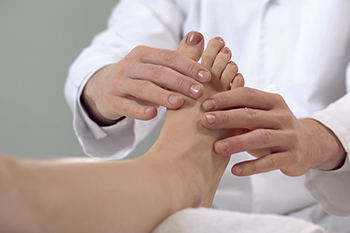
Most babies are born with flat feet, but the arch fully develops during the teenage years. There are some children that have a joint hypermobility condition, and this is referred to as low muscle tone. This may prevent the arch from developing, which could result in having flat feet in their adult years. One type of flat feet is called flexible flat feet. The ligaments hold the bones in place in addition to supporting the arches. Children who have joint hypermobility do not have the same support as those without it, and the ligaments are more flexible than normal. There are stretches and exercises that can be performed that may help to strengthen the arch. An effective stretch is done by standing up while slightly leaning back. This will propel the muscles in the front of the ankle to become stronger. Additionally, standing on one leg will activate the muscles in the ankle to maintain balance as well as stability. If you have questions about flat feet and would like to learn more about how to perform effective stretches, please schedule a consultation with a podiatrist.
Flatfoot is a condition many people suffer from. If you have flat feet, contact Dr. Barbara Davis from Gilbert Podiatry. Our doctor will treat your foot and ankle needs.
What Are Flat Feet?
Flatfoot is a condition in which the arch of the foot is depressed and the sole of the foot is almost completely in contact with the ground. About 20-30% of the population generally has flat feet because their arches never formed during growth.
Conditions & Problems:
Having flat feet makes it difficult to run or walk because of the stress placed on the ankles.
Alignment – The general alignment of your legs can be disrupted, because the ankles move inward which can cause major discomfort.
Knees – If you have complications with your knees, flat feet can be a contributor to arthritis in that area.
Symptoms
- Pain around the heel or arch area
- Trouble standing on the tip toe
- Swelling around the inside of the ankle
- Flat look to one or both feet
- Having your shoes feel uneven when worn
Treatment
If you are experiencing pain and stress on the foot you may weaken the posterior tibial tendon, which runs around the inside of the ankle.
If you have any questions please feel free to contact our office located in Gilbert, PA . We offer the newest diagnostic and treatment technologies for all your foot and ankle needs.